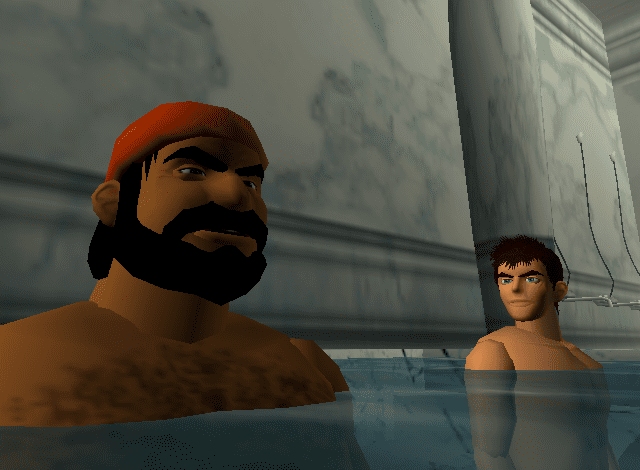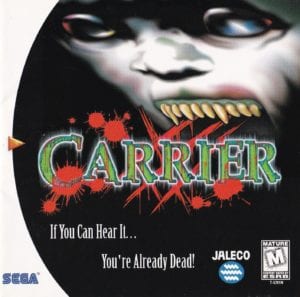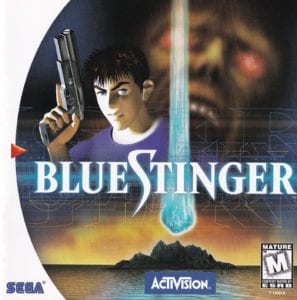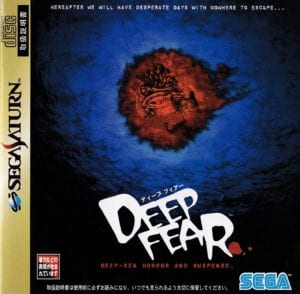
The Play List: A ‘deep dive’ into the Dreamcast’s water-based horror games
High-seas horror will leave you with haunted 'dreams'
Water sucks. It tastes bland, germs live in it and just to emphasize its pettiness, the most plentiful sources are salted, unfit for human consumption. I mean, come on, the oceans are taking up valuable space. Space that could be used for condos or something. Also, it’s lethal in every form. Icicles impale an estimated 400 people per year (citation needed), you can drown in as little as an inch of liquid water, and steam burns are the worst type of burn you can sustain (citation: my ninth-grade science teacher).
What I’m trying to say is, water sucks, and you should be very, very scared of it. The following three horror games prey on the hydrophobic, amplifying worst-case (and I mean worst-case) scenarios of human/water interaction.
Carrier
 A horror story set to the backdrop of global conflict, Earth’s north and south hemispheres are at war, fighting for control of the planet’s dwindling resources. The game’s broader setting is set up via the opening cinematic, though Carrier itself takes place in a small, isolated corner of this dark new world.
A horror story set to the backdrop of global conflict, Earth’s north and south hemispheres are at war, fighting for control of the planet’s dwindling resources. The game’s broader setting is set up via the opening cinematic, though Carrier itself takes place in a small, isolated corner of this dark new world.
The Hemidal, the north hemisphere’s ultimate weapon, is on route back to North America. Partway there, contact is lost with the gigantic sea vessel. Jack Ingles and Jessifer Manning, members of the SPARC team, have been assigned with investigating the communication failure. Upon approaching the ship, they are shot down. Crash landing on the deck, it quickly becomes clear the Hemidal’s communication issues are now the least of their problems.
Carrier isn’t so different from its survival horror contemporaries, with resource management, puzzle solving, and item collection within fixed camera environments at the forefront of design. It also splits the game’s story between two vantage points. Jack’s campaign comes first and is the longer and more challenging of the two. Jessifer’s campaign is unlocked after completing Jack’s, adding new perspective to the overarching plot, but changing little in terms of core gameplay.
While Carrier quite obviously pulls most of its inspiration from the Resident Evil series, it does make a few smart improvements to the formula – namely in the area of combat. While ammunition is scarce in Carrier, all is not lost if you run out of bullets. A handheld welder, Carrier’s answer to Resident Evil’s knife, is a competent ranged weapon, even with its low damage output and firing rate. T9 bombs — carried in packs of 20 and infinitely refillable via the game’s armories — are another alternative when running low on ammo. It’s risky to use them, as they explode after three seconds once planted. However, bottlenecking a horde of mutants into a perfectly set trap is well worth the payoff.
Carrier is played from fixed-camera perspectives, utilizing tank controls. Raising you weapon will snap aim to the nearest enemy. Once you have taken aim at an enemy, a reticle will show up on the creature’s body, showing which part Jack or Jessifer are aiming at. You may want to take out an enemy’s legs in order to sprint around them. Or, you may want to go for a headshot, taking them out for good. The dismemberment isn’t unlike what Dead Space would later utilize, albeit to a lesser degree. Its inclusion makes the game more strategic, cutting down on wasted shots while also showcasing some pretty cool damage modeling.
Carrier’s environments are built in-game, real time. This allows for some neat dynamism and panning, the camera sometimes moving with the player as they walk. The real-time environments also allow for another key feature: the BEM-T3 Scope. At any point, players can stop and use this scope to better examine their surroundings. All other actions are frozen while in first-person, thus players need be cautious in their use of it. The BEM-T3 is capable of alerting players to enemies (both visible and invisible), items, and even hidden passageways thanks to an x-ray capable of penetrating the ship’s foliage.
All of these little improvements to the genre standard formula help make Carrier more approachable for survival horror newcomers – especially nowadays – while also entertaining survival horror vets. If there is one criticism of Carrier, it’s that it’s just not that scary. The story, while corny, hits all the points a good zombie/disaster game should. The environments are creepy and dark, mixing things up between pitch black corridors and thick jungle-like growth. Unfortunately, none of it seemed to be crafted with horror in mind, scares being few and far between. The sound design is serviceable, but it does little to actually put players on edge. Likely, you’ll bank around a corner or two without checking your scope first, running straight into a waiting zombie. But other than player error, the Carrier is pretty tame stuff.
Until you reach the ship’s fifth deck.
Plumbing Issues
Trudging through knee-deep water, this semi-flooded hell makes up for the comparatively cheery decks 1-4. Here, swimming enemies are introduced. Silent and near invisible, creatures just below the surface stalk Jack and Jessifer as they clumsily trudge through the flooded corridors. These man-fish hybrids are a substantially less-hot than your average mermaid, patrolling their still-water domain for prey. Due to player’s restricted movement, the only feasible way to hunt these monstrosities is by shooting them from a distance.
Once they close in, Jack and Jessifer have little hope of escaping with their torsos in-tact. The structural state of the fifth deck is suspenseful enough, water slowly filling entrapped spaces. The inclusion of swimming enemies is a brilliant and brief tease of the horror waiting to be unleashed should Jack and Jessifer fail in their mission.
Blue Stinger

Set in the not so distant future of 2018, a strange rock has emerged from the depth of the ocean. Theorized to be the meteorite that struck Earth thousands of years ago, killing the dinosaurs, the island is somewhat confusingly named Dinosaur Island. Soon populated and developed, Dinosaur Island becomes something of a hybrid resort town and laboratory, scientists digging into the extraterrestrial rock.
Elliot Ballad, an ESER agent, has decided to take his vacation on Dinosaur Island. In a comical stroke of bad luck, a new meteor strikes the old meteor, enveloping the island in a mysterious blue dome. Elliot washes ashore hours later and is soon introduced a woman named Jeanine via emergency radio broadcast. Jeanine tells Elliot how to reach her and advises he pick up a weapon on the way, as the island is experiencing something of a dinosaur related emergency. Teaming up with a sailor named Dogs, the two make their way to Jeanine, set up a command center, and begin their quest to stop the deadly mutation plaguing the island.
A launch game for the Dreamcast, Blue Stinger wasn’t (and still isn’t) much of a looker. The character models look like they’re made of hot dog wieners, the lip-syncing doesn’t match the Japanese voice track let alone English, and each character seems capable of only about six unique animations. Controls can only be described as “wobbly”, always pushing Dogs and Elliot slightly to the left.
The cinematic camera, which turns on during boss battles, has a hard time deciding whether to focus on the creature you’re fighting or your character’s feet. Understandably, Blue Stinger turns a lot of players away before it even gets going. However, those who stick with it, accepting the game as it is, will find it has so much to offer underneath its visual blemishes and control issues. Blue Stinger is an innovative, funny, and sometimes thrilling, horror adventure.
There are a few things Blue Stinger does very differently from the other two games on this list. For one, Blue Stinger is played from a third-person perspective with the camera trailing behind the player instead of being fixed (save for boss fights), allowing for more visceral and dynamic combat. Speaking of which, most monsters drop cash when killed.
Though Blue Stinger still requires your standard survival horror resource management, the monetary system allows players to purchase ammunition, weapons, and health upgrades at their discretion. This is complimented by the game’s more open design, encouraging players to shop around, finding new items and weapons available in the island’s plethora of vending machines.
Blue Stinger also incorporates a melee combat system, with Elliot sporting sword and rod weapons while Dogs puts on different martial arts t-shirts for hand to hand combat (Too bad TapOut shirts don’t work like that in real life, right, MMA fans?). This was useful for players who wanted to grind JRPG style without wasting ammo every repeat encounter.
Here fishy fishy fishy…
The partners also vary in terms of ability. Elliot moves faster than Dogs at the cost of a smaller health bar. He also has a larger arsenal of weapons to choose from, though Dogs’ weapons do more damage.
However, the most notable of the pair’s differences is Elliot’s ability to swim. Though much of the game can be completed as either character, certain sequences have to be played with Elliot. Water rescues may be Elliot’s profession, but that doesn’t count for much when you’re stuck underwater with fanged, finned, prehistoric monstrosities capable of tearing flesh from bone like a buzz saw. Elliot can shoot some small arms underwater, but more often than not you’ll need to swim around the enemies or take them out on dry land as opposed to going head to head at an extreme disadvantage.
Blue Stinger’s underwater sequences work as well as they do not only because of the horrific creatures lurking below the surface, but because they highlight just how vulnerable humans are in water. If the mutants don’t get Elliot, lack of oxygen will. Yet, if he chooses to tread for too long, catching his breath, he risks losing his window of escape, hopelessly outpaced by the speed and ferocity of the creatures below.
Deep Fear

Dubois is undoubtedly Sega’s best gay stereotype since Streets of Rage 3’s Ash. Tragically, it seems SEGA once again thought our North American brains wouldn’t be able to handle his flamboientness, and Deep Fear never saw a stateside release.
John Mayor (no, not John Mayer, unfortunately) is a former Navy SEAL, now contracted engineer, working in an underwater facility known as The Big Table. Contrary to ’90s children propaganda, things most certainly do not get better down where it’s wetter, and Deep Fear opens with the Big Table succumbing to mass infection thanks to a crash-landed chimp astronaut.
It’s just as awesome as it sounds.
The facility’s crew soon begin mutating into horrific, rabid, monsters. John, equipped with navy training and mechanical knowhow, must navigate through the collapsing structure and come face to face with his darkest fears.
While more or less what you would expect of a Resident Evil clone, Deep Fear manages to stand out because of its terrific marriage of story and gameplay. The setup is slow, with players free to roam the facility and interact with crew, the monsters’ unveiling saved for later in the game. This helps build rapport, players becoming more attached to John, making ensuing violence all the more impactful.
How do I breathe without you?
Deep Fear is a game that should be celebrated for its innovations as much as its imitations. Coupled with genre staple ammo and health management, Deep Fear also requires players watch John’s oxygen supply. With life support systems failing throughout the base, John will need to carefully plan his route between refill terminals.
Typically, survival horror games make players chose their fights carefully in order to preserve ammunition and minimize potential damage to their health. This holds true in Deep Fear, though the ever-dwindling oxygen meter elevates the challenge further, players having to adapt to unforeseen obstacles in order to keep breathing — let alone save bullets — between refill stations.
Though the voice acting isn’t much higher than then SEGA-standard House of the Dead level, Deep Fear‘s story is surprisingly involving, John being more developed than your everyday Chris Redfield. Having lost his fiancée in a yachting accident three years prior, his placement in the depths of the very ocean which stole her makes for an uneasy bit of tension. Running about the facility, avoiding or shooting your infected crewmates is one thing. Suiting up in a Big Jim – the game’s deep-sea protection suits – to walk on the ocean floor is a whole ‘nother.
Deep Fear‘s hydrophobia is more visceral than either other game on this list. With John’s crewmates dying at either his hand or that of the infection, coupled with the haunting memory of his loved one, Deep Fear pulls off something of an impressive psychological action/horror meld. That’s not to say it’s a heartbreaking work of staggering genius. Deep Fear, like many horror games of its era, ends up being funny more often than scary. However, its gameplay innovations and intertwining themes make it stand it out among horror games of the time, especially on console.
Conclusion
The moral of the story: no good can come from water. Hopefully, Nestle’s effort to bottle and contain this horrid substance will be successful, saving countless lives needlessly lost to irresponsible hydration and/or dinosaur contamination. Until then, stay on land, drink only soda, and remember to play lots and lots of SEGA.

